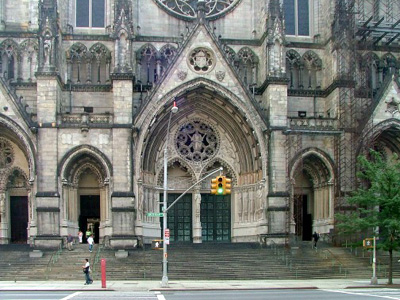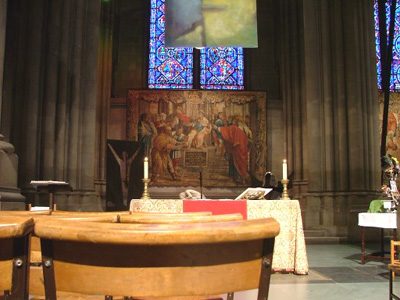 |
||||||||||
 |
||||||||||
|
1164: Cathedral of St John the Divine, New York City Mystery Worshipper: Misericord. The church: Cathedral of St John the Divine, New York City. Denomination: Episcopal Church in the USA. Comment: We have received a comment on this report. The building: The seat of the diocese of New York, St John the Divine is the largest gothic church in the world and the second largest church in any style – only St Peter's Basilica in Rome is larger. The cornerstore was laid in 1892 but the grand plan envisioned by the noted ecclesiastical architect Ralph Adams Cram and the firm of Heins & LaFarge (designers of the legendary City Hall subway station and the Bronx Zoo) has proceeded fitfully, and now, 113 years later, the still unfinished building has fallen on hard times. Most of the grounds are fenced off with nasty looking chain link. The scaffolding still in place for the southwest tower looks like it is rusting on the stonework, and the northwest tower remains unbegun. The north transept was ravaged by fire in 2001, and the cathedral has struggled to recover from that tragic event. The once impressive vista of 601 feet from the west doors to the east chapel window has been cut back by a large black veil that hangs from the crossing arch and hides the (one assumes) damaged and disheveled choir from view. I was reminded of the black drapery that enshrouds one of the destroyed but still-standing buildings at the World Trade Center site. The church: This is a place where history has been made. During the second World War, several pieces of silver and jewelry from London's Chapel Royal were transferred to St John's for safekeeping; rumor quickly spread that the Crown Jewels themselves were among said treasures. In 1951 an ecumenical service was held commemorating the 1500th anniversary of the Council of Chalcedon. In 1968 Duke Ellington premiered his Second Sacred Concert at the cathedral; Ellington's funeral in 1974 was attended by 12,500 mourners. During the 1960s the cathedral championed the fledgling civil rights movement, causing several wealthy patrons to withdraw their financial support. In 1973 Tennessee Williams was honored at an evensong service incorporating readings from several of his works. In 1978 the first women priests were ordained at the cathedral; one of these, Mary Simpson, was later appointed canon and thus became the first female canon in the history of Christianity. The Dalai Lama has visited the cathedral numerous times. Today, despite financial difficulties that have resulted in the building's remaining unfinished, the cathedral continues its long tradition of association with the most pressing and often controversial social issues of the day. The neighborhood: Cathedral Parkway (110th Street) marks the boundary between Central Park and Harlem. The area surrounding the cathedral includes Columbia University and is most pleasant – not as fancy as Park Avenue certainly, but anyone seeking a quieter residential urban experience with a collegiate presence would find this area perfect. As Manhattan's upper west side merges with Harlem, diversity of races and economic strata becomes more apparent. The cast: The Rev. Patti Welch, chaplain of the cathedral school and minister for education, was the celebrant. The Rev. Canon Thomas P. Miller was the preacher. The date & time: August 21, 2005, 9.00am. I chose the early service knowing that at the later service there would be no organ (damaged by the fire and still under repair) or choir (summer recess). What was the name of the service? Eucharist, fourteenth Sunday after Pentecost. How full was the building? A rather unfair question given the cathedral's present state. A bay in the nave had been set up with about 100 chairs for this early morning service and about 40 people showed up on a muggy summer Sunday. Did anyone welcome you personally? Yes. After ascertaining that I was there for the service and not as a tourist, a guide greeted me and gave me a service sheet. She indicated that the nearer group of chairs facing an altar midway along the south aisle was where the service would be held. Was your pew comfortable? The nave is a veritable sea of chairs, all of which are serviceable (pun intended). How would you describe the pre-service atmosphere? Quiet and prayerful. As seems common at small early services, most people in attendance knew each other. It felt like the early service at a neighborhood parish of 150 or so members. What were the exact opening words of the service? "Blessed be God: Father, Son and Holy Spirit." What books did the congregation use during the service? Everything was printed in the very nice service sheet. No books were in sight. What musical instruments were played? Piano. The pianist's name was not given, although I assume that the cathedral has kept its regular music staff on despite the fire. Did anything distract you? As will be apparent from the photographs, there are many visual distractions on many different layers. The sheer volume of space comprising the nave is awesome. The stained glass is breathtakingly magnificent. Several outstanding tapestries that escaped fire and smoke are hung about, along with a series of quite nice modern paintings. The list goes on and on. I should say that these are pleasant distractions. There were no human distractions – for example, I didn't see any really small children at this service. Everyone present was perfectly attuned to this occasion of worship. Was the worship stiff-upper-lip, happy clappy, or what? This was an example of an intimate liturgy with suitably scaled music and ceremony. Mother Welch in particular projected a very welcoming and Christ-centered joy.  Exactly how long was the sermon? 13 minutes. On a scale of 1-10, how good was the preacher? 8 – Canon Miller had prepared his sermon well, and I found it fresh and stimulating. In a nutshell, what was the sermon about? Canon Miller tied the reading from Matthew where Jesus asks Peter, "Who do you say that I am?" to our efforts to conform, good and bad. He used the example of a Bertolucci film that I was not familiar with. We were encouraged to conform to the image of Christ in a positive way, as the image of believers. "The common good" is both a Christian as well as civic concept. Which part of the service was like being in heaven? Sharing in the sacraments and good teaching are what worship is really about. And which part was like being in... er... the other place? It is hard to escape the feeling that St John the Divine as a cathedral building is a hopeless cause. It had been about 18 years since my last visit, and in spite of the progress on the south tower (all made at least a decade ago) the cathedral still looks obviously unfinished and is even beginning to show signs of neglect. It stands as a sad, poor relation to other edifices of similar scale, such as the Washington National Cathedral. What happened when you hung around after the service looking lost? Mother Welch greeted everyone, and people either mingled in the groups they came with or moved along. Others were coming to the later service held in another "campsite" further up the nave, and the tourist activity was beginning to pick up. How would you describe the after-service coffee? I didn't see any. It would have been a nice gesture of fellowship. I also looked for any remnant of the gift shop, which is where the north transept fire had started, but found none. I wondered why a temporary gift shop had not been set up – the old gift shop was an important source of revenue. Recordings of the cathedral's fine choir and organ, t-shirts, posters, books, whatever, could help engage the visitor and dispel the impression that nothing is happening. How would you feel about making this church your regular (where 10 = ecstatic, 0 = terminal)? 4 – Wow. I guess maybe if I lived here, but it would be a challenge, with the many other fine houses of Anglican worship in New York. Did the service make you feel glad to be a Christian? Oh yes. Things that have an appearance of hopelessness are great opportunities for faith. I'm not just saying that, but needing to have faith, rather than just coasting on a church that is a well-oiled machine, can be a really positive experience. What one thing will you remember about all this in seven days' time? I will remember the depressing condition of the building on the one hand, and the warmth and welcome shown by the clergy on the other hand. A 25 year-old guide book I have to the cathedral points out that for the price of one of our military's super bombers this cathedral could be completed. I'm guessing that was never more true or to the point. |
|
|
||||||||||||||||||||||||||||||||||||
| More Mystery Worshipper reports | |||||||||||||||||||||||||||||||||||||||
 |
|||||||||||||||||||||||||||||||||||||||






